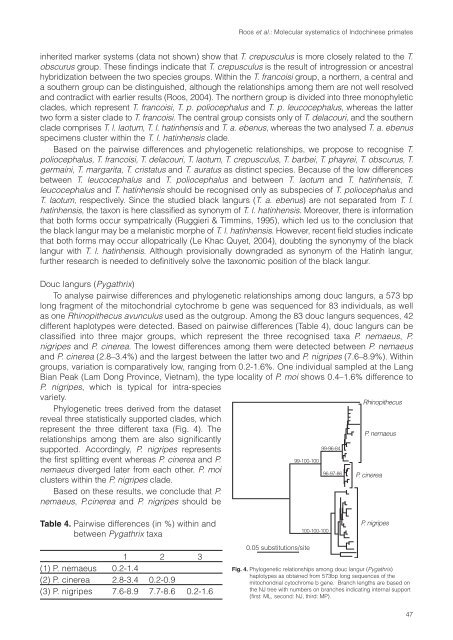Vietnamese Journal of Primatology - Frankfurt Zoological Society
Vietnamese Journal of Primatology - Frankfurt Zoological Society
Vietnamese Journal of Primatology - Frankfurt Zoological Society
You also want an ePaper? Increase the reach of your titles
YUMPU automatically turns print PDFs into web optimized ePapers that Google loves.
Roos et al.: Molecular systematics <strong>of</strong> Indochinese primates<br />
inherited marker systems (data not shown) show that T. crepusculus is more closely related to the T.<br />
obscurus group. These findings indicate that T. crepusculus is the result <strong>of</strong> introgression or ancestral<br />
hybridization between the two species groups. Within the T. francoisi group, a northern, a central and<br />
a southern group can be distinguished, although the relationships among them are not well resolved<br />
and contradict with earlier results (Roos, 2004). The northern group is divided into three monophyletic<br />
clades, which represent T. francoisi, T. p. poliocephalus and T. p. leucocephalus, whereas the latter<br />
two form a sister clade to T. francoisi. The central group consists only <strong>of</strong> T. delacouri, and the southern<br />
clade comprises T. l. laotum, T. l. hatinhensis and T. a. ebenus, whereas the two analysed T. a. ebenus<br />
specimens cluster within the T. l. hatinhensis clade.<br />
Based on the pairwise differences and phylogenetic relationships, we propose to recognise T.<br />
poliocephalus, T. francoisi, T. delacouri, T. laotum, T. crepusculus, T. barbei, T. phayrei, T. obscurus, T.<br />
germaini, T. margarita, T. cristatus and T. auratus as distinct species. Because <strong>of</strong> the low differences<br />
between T. leucocephalus and T. poliocephalus and between T. laotum and T. hatinhensis, T.<br />
leucocephalus and T. hatinhensis should be recognised only as subspecies <strong>of</strong> T. poliocephalus and<br />
T. laotum, respectively. Since the studied black langurs (T. a. ebenus) are not separated from T. l.<br />
hatinhensis, the taxon is here classified as synonym <strong>of</strong> T. l. hatinhensis. Moreover, there is information<br />
that both forms occur sympatrically (Ruggieri & Timmins, 1995), which led us to the conclusion that<br />
the black langur may be a melanistic morphe <strong>of</strong> T. l. hatinhensis. However, recent field studies indicate<br />
that both forms may occur allopatrically (Le Khac Quyet, 2004), doubting the synonymy <strong>of</strong> the black<br />
langur with T. l. hatinhensis. Although provisionally downgraded as synonym <strong>of</strong> the Hatinh langur,<br />
further research is needed to definitively solve the taxonomic position <strong>of</strong> the black langur.<br />
Douc langurs (Pygathrix)<br />
To analyse pairwise differences and phylogenetic relationships among douc langurs, a 573 bp<br />
long fragment <strong>of</strong> the mitochondrial cytochrome b gene was sequenced for 83 individuals, as well<br />
as one Rhinopithecus avunculus used as the outgroup. Among the 83 douc langurs sequences, 42<br />
different haplotypes were detected. Based on pairwise differences (Table 4), douc langurs can be<br />
classified into three major groups, which represent the three recognised taxa P. nemaeus, P.<br />
nigripes and P. cinerea. The lowest differences among them were detected between P. nemaeus<br />
and P. cinerea (2.8–3.4%) and the largest between the latter two and P. nigripes (7.6–8.9%). Within<br />
groups, variation is comparatively low, ranging from 0.2-1.6%. One individual sampled at the Lang<br />
Bian Peak (Lam Dong Province, Vietnam), the type locality <strong>of</strong> P. moi shows 0.4–1.6% difference to<br />
P. nigripes, which is typical for intra-species<br />
variety.<br />
Phylogenetic trees derived from the dataset<br />
reveal three statistically supported clades, which<br />
Rhinopithecus<br />
represent the three different taxa (Fig. 4). The<br />
relationships among them are also significantly<br />
P. nemaeus<br />
supported. Accordingly, P. nigripes represents<br />
99-96-84<br />
the first splitting event whereas P. cinerea and P.<br />
99-100-100<br />
nemaeus diverged later from each other. P. moi<br />
clusters within the P. nigripes clade.<br />
Based on these results, we conclude that P.<br />
nemaeus, P.cinerea and P. nigripes should be<br />
96-97-86 P. cinerea<br />
Table 4. Pairwise differences (in %) within and<br />
between Pygathrix taxa<br />
1 2 3<br />
(1) P. nemaeus 0.2-1.4<br />
(2) P. cinerea 2.8-3.4 0.2-0.9<br />
(3) P. nigripes 7.6-8.9 7.7-8.6 0.2-1.6<br />
0.05 substitutions/site<br />
100-100-100<br />
P. nigripes<br />
Fig. 4. Phylogenetic relationships among douc langur (Pygathrix)<br />
haplotypes as obtained from 573bp long sequences <strong>of</strong> the<br />
mitochondrial cytochrome b gene. Branch lengths are based on<br />
the NJ tree with numbers on branches indicating internal support<br />
(first: ML, second: NJ, third: MP).<br />
47
















